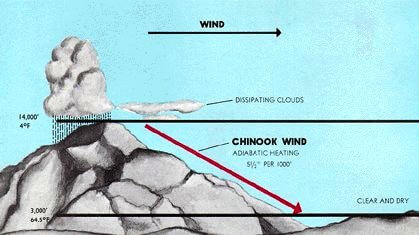Ricochet is the best place on the internet to discuss the issues of the day, either through commenting on posts or writing your own for our active and dynamic community in a fully moderated environment. In addition, the Ricochet Audio Network offers over 50 original podcasts with new episodes released every day.
 DiCaprio Cites Extremely Common Alberta Weather Phenomenon as a Symptom of Climate Change
DiCaprio Cites Extremely Common Alberta Weather Phenomenon as a Symptom of Climate Change

“Is it warm, here?”
Oh, Leo. Bless his little heart. In a industry interview for his recent movie, The Revenant — which was filmed near Calgary, Alberta — DiCaprio discussed his horror when he experienced a warm wind blowing across the frosty landscape.
“We were in Calgary and the locals were saying, ‘This has never happened in our province ever.’ We would come and there would be eight feet of snow, and then all of a sudden a warm gust of wind would come … it was scary. I’ve never experienced something so firsthand that was so dramatic. You see the fragility of nature and how easily things can be completely transformed with just a few degrees difference. It’s terrifying, and it’s what people are talking about all over the world. And it’s simply just going to get worse.”
 I wonder which “locals” said that to him, because the phenomenon Dicaprio experienced was merely a Chinook wind, which are extremely common in southern Alberta (also in Montana). The Chinooks are, arguably, a big reason why settlers decided to settle in southern Alberta in the first place, since it provided them with a periodic respite from the long Canadian winter.
I wonder which “locals” said that to him, because the phenomenon Dicaprio experienced was merely a Chinook wind, which are extremely common in southern Alberta (also in Montana). The Chinooks are, arguably, a big reason why settlers decided to settle in southern Alberta in the first place, since it provided them with a periodic respite from the long Canadian winter.
Here’s a description of the phenomenon from 115 years ago:
Those who have not the warm, invigorating chinook winds of this country, cannot well comprehend what a blessing they are. The icy clutch of winter is lessened, the earth throws off its winding sheet of snow. Humanity ventures forth to inhale the balmy spring like air. Animated nature rejoices.
According to Wikipedia, Chinook winds have been observed to raise winter temperature, often from below -20°C (-4°F) to as high as 10-20°C (50-68°F) for a few hours or days, then temperatures plummet to their base levels. The greatest recorded temperature change in 24 hours was caused by Chinook winds on January 15, 1972, in Loma, Montana; the temperature rose from -48 to 9°C (-54 to 48°F).
“The Revenant 2015” by Source. Licensed under Fair use via Wikipedia.
Published in General




I don’t want to be accused of “conspiracy” but I wonder who wrote Leo’s lines?
After a decade of increasingly harsh winters here in Wisconsin, we’re having a nice green December. Naturally, the Warmists are freaking out!
I’ve tried patiently to explain that these are normal, natural cycles, that there’s this regularly-scheduled thing called “El Niño,” and I’ve tried to remind them how miserably cold and snowy the last decade was, but it’s like they just woke up yesterday.
But I’m enjoying this respite.
Funny how a decade of harsh winters is “just weather” but one warm December is GLOBAL WARMING!
Biggest perpetrator of this fearmongering: The Weather Channel. They need a competitor.
As long as they don’t try to Arabic-ize them to be “siroccos” (like they are trying to call AZ dust storms “haboobs”).
Seriously?
Is that a concession to the ISIS operatives entering Arizona across the border?
“I’ve tried patiently to explain that these are normal, natural cycles, that there’s this regularly-scheduled thing called “El Niño,” and I’ve tried to remind them how miserably cold and snowy the last decade was, but it’s like they just woke up yesterday.”
Your main point is well-taken, but I wouldn’t call El Niño regularly-scheduled. In fact, I’d consider accurately predicting it to be a good test for a climate model.
Here’s a recent paper on the accuracy of predictions. I’ve only read the abstract but it sounds like it is not a solved problem yet.
http://journals.ametsoc.org/doi/abs/10.1175/BAMS-D-11-00111.1
I don’t really care about Leo, but thank you for explaining Chinook Winds -I’d heard the term, but wasn’t sure of the meaning other than “wind in cold places.”
Look the guy has recently been molested by a large bear, hasn’t he suffered enough? Must the traumatized fellow have his every statement dissected and subject to ridicule? Leave DiCaprio alone!
Well, that’s my take on it. Jon G likes to say “haboob” (and irritate his dad).
On the same sort of note, I’ve met old Arizonans who say that they didn’t have monsoons when they were kids.
Monsoons? Does that happen in Arizona? I thought drought was a problem in the Southwest. Now the problem is rain? Is anyone ever happy?
I remember when I used to be able to get Joe Soucheray’s radio show out of the Twin Cities, and whenever the weather guy would come in with the forecast, he would wind up the segment by saying “More proof of global warming!” No matter what the weather was.
And that’s true. More and larger hurricanes are caused by global warming. Fewer and/or smaller hurricanes are global warming. Snowy winter? Global warming. Not as snowy? Global warming. Warm summers? Well, duh. Cold summers? Ah, trick question! That’s global warming, too.
Earthquakes? Yes. Global warming.
And the solution to global warming is somehow exactly the same as when the problem was global cooling. Give more money to the government.
The Southwest has summer thunderstorms. Some yahoos (probably Californians who came before me and set a bad tone) decided that since the weather pattern is similar to the monsoons of India that’s what the storms should be called. . . might be the same folks who move to the Sonoran Desert and complain that it’s hot in the summer. Or those who move to Prescott and think they are in the desert. . .
Imagine if they moved to Arizona to experience winter. But then they moved to Arizona in order not to experience winter. Snow birds I have heard them called. Do they bring the snow with them?
I’m worried, not because of global warming, but because I figure the longer the good weather lasts the worse the bad weather will be when it comes.
It also seems that winter (as defined by snow staying on the ground) has been starting later in the year, which is balanced out by it lasting longer into what would normally be spring. Not sure if there’s any data to back that up though.
I think it’s actually been starting earlier, with this year a bit of an outlier. Definitely staying later, though.
Spring of 2014 and 2013, the snowbank in our parking lot didn’t melt away until late May. And I think it was November 2012 when the snow came in the first half of November, and nobody saw grass again until the second week of May. I remember reading a couple pieces about the psychological effect six months of total snow cover was having on people.
So we’re about due for a less severe winter, and probably given the general angst permeating the culture, that’s not a bad thing. Otherwise, everyone tends to go around looking like they’re about to stab someone.
You tell me:
Monsoons? You mean like 6 months of downpours?
No. That’s why it is lame. It’s just the weather flow pattern: moist air from the Gulf (of Mexico, of California? ) hits the warm dry air of the Colorado plateau and clouds form and sometimes it dumps some goodly amount of rain. The “season” used to be based on dew point and some other real meteorologic data but now it’s June 15th to September 30th.
Cools things off nicely when it does rain.
I grew up in Calgary. I remember as many muddy Christmases as I do white ones. I pity people like Mr. DiCaprio who live in fear of the vengeful weather gods.
Of course, that is the solution they have for EVERY problem.
I thought DiCaprio went down when the Titanic hit an iceberg because of global cooling. Read this:
http://drtimball.com/2012/titanic-unusual-climate-extreme-ice-conditions-result-tragic-accident/
Let me distill this for readers. Leo, you’re a dumb bastard.
Drew,
Monsoons don’t really have anything to do with rain. A monsoon is a change in the seasonal prevailing wind.
Here in the Southwest (I live in just outside of Albuquerque) the winter weather pattern has low pressure cells swoop in from the Northwest occasionally bringing rain or snow. As we move into the summer months the prevailing weather is from the Southwest coming in from the Gulf of California bringing summer thunderstorms. Since the annual rainfall here is only around 10 inches, neither weather pattern is all that wet.
He expects us to buy this nonsense!
The part about talking to locals I mean…
During my 45 years in Oklahoma there was never a winter that the locals didn’t refer to as “The most unusual we’ve ever had.” It was like they had no memory at all of past ‘unusual’ weather. So it was either unusually cold, unusually warm, unusually wet, or unusually dry, every year. Well, yes, of course, every year is a little different, so get used to changing weather. But if you take even a cursory look at averages, monthly or seasonally, over time, they pretty much look static, only minor changes of temperatures and precipitation.
It’s all hype designed to justify new taxes and/or sell products including but not limited to The Weather Channel (seriously a whole TV channel of nothing but weather, how COULD you fill the time?).
Reasonable, thinking people are fully justified in discounting the whole charade unless or until actual data is accumulated to verify the claims. I doubt, but can’t categorically deny that will ever happen. Meantime, please keep your hands off my wallet.
Just another Meat Puppet, too stupid to actually construct a coherent thought unless it’s put there by an actual sentient intelligence.
So, one Canadian says to the other Canadian, “Watch this…”
My father, born and raised in Minnesota, lived in Quartzite for many winters. It permitted him to avoid the kind of snow and cold that Minnesota offers its people in the winter. Of note, my father was not a skier, so that would not have been an inducement to winter in Quartzite.
Snowbirds go to places like Arizona to avoid the worst ravages of winter, and often – as in Quartzite – share a community of like-minded people from other cold climes who have departed those places.
A bit of cool? Nothing for people from Michigan, Minnesota, the Dakotas or the highline of Montana. Jacket weather with the plus that the rattlesnakes aren’t out and about. A bit cold for a cold-blooded reptile.
We have chinooks in Colorado, totally normal. In Denver this week, it’s been about 60-65 degrees under the influence of a chinook, which I think comes from a Native American word meaning “snow eater” since the winds tend to melt the snow rapidly. Yes, nice respite from the cold.
The name of the Indian tribes around the Columbia river are Chinooks. The area really doesn’t see much snow (sea level and just above it) so I can’t image it means “snow eater”.
Here’s more on DiCaprio from the Breit Bart ..
Leo’s General Equivalency Diploma is showing.